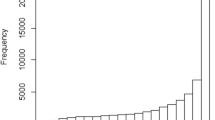Abstract
Adults were tested for the way in which they process four types of subject and object relative clauses. The results support an anti-interruption and anti-rearrangement constraint that has been proposed by Slobin. The reason why interruption and rearrangment of linguistic units is hard for adults is explained in terms of language-processing strategies that they are hypothesized to be using, in particular the Adjacency strategy. Adult behavior is compared to the performance of 4- and 5-year-old children in a previous study. The results of these two studies support the claim that children and adults are following the same strategies in processing these sentences, and that the difference between them is in which strategies they rely most heavily on, and, consequently, which sentences they make the most mistakes on.
Similar content being viewed by others
References
Bever, T. G. (1970a). The cognitive basis for linguistic structures. In Hayes, J. R. (ed.),Cognition and the Development of Language, Wiley, New York.
Bever, T. G. (1970b). The influence of speech performance on linguistic structure. In Flores d'Arcais, G. B., and Levelt, W. J. M. (eds.),Advances in Psycholinguistics, American Elsevier, New York.
Blumenthal, A. L. (1966). Observations with embedded sentences.Psychon. Sci. 6:453–455.
Brown, H. D. (1971). Children's comprehension of relativized English sentences.Child Dev. 42:1923–1926.
Chipman, H. (in press).Children's Construction of the Pronominal System, Hans Huber Press, Bern.
Chomsky, N. (1965).Aspects of the Theory of Syntax, MIT Press, Cambridge, Mass.
Fodor, J., and Garrett, M. (1967). Some syntactic determinants of sentential complexity.Percept. Psycholphys.,2:289–296.
Foss, D. J., and Lynch, R. H. (1969). Decision processes during sentence comprehension: Effects of surface structure on decision times.Percept. Psychophys. 5:145–148.
Hakes, D. T., and Cairns, H. (1970). Sentence comprehension and relative pronouns.Percept. Psychophys. 8:5–8.
Hakes, D. T., and Foss, D. J. (1970). Decision processes during sentence comprehension: Effects of surface structure reconsidered.Percept. Psychophys. 8:413–416.
Maratsos, M. P. (1973). The effects of stress on the understanding of pronominal co-reference in children.J. Psycholing. Res. 2:1–8.
Sheldon, A. (1974a). The acquisition of relative clauses in English. Doctoral dissertation, Indiana University Linguistics Club publication.
Sheldon, A. (1974b). The role of parallel function in the acquisition of relative clauses in English.J. Verb. Leran. Verb Behav. 13:272–281.
Slobin, D. I. (1971). Developmental psycholinguistics. In Dingwall, W. O. (ed.),A Survey of Linguistic Science, Linguistics Program, University of Maryland.
Stolz, W. S. (1967). A study of the ability to decode grammatically novel sentences.J. Verb. Learn. Verb. Behav. 6:867–873.
Author information
Authors and Affiliations
Additional information
This research was supported by a Grant-in-Aid from the Graduate School of the University of Minnesota.
Rights and permissions
About this article
Cite this article
Sheldon, A. On strategies for processing relative clauses: A comparison of children and adults. J Psycholinguist Res 6, 305–318 (1977). https://doi.org/10.1007/BF01068301
Received:
Issue Date:
DOI: https://doi.org/10.1007/BF01068301




